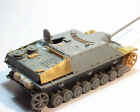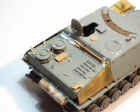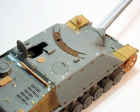|
Last summer I read a volume by M. Jaugitz (Funklenkpanzer: A history of German Army Remote- and Radio-Controlled Units, J.J. Fedorowicz Publishing, 2001) concerning the panzer units equipped with remote and radio controlled demolition chargers. Among these Abteilungen had a rather unknown unit from Wehrmacht which fought in fierce battles for Seelow Heights and Berlin in the last stage of the world war II: Panzer Abteilung (Fkl) 303 which later became the Panzer Abteilung Schlesien. This unit was equipped with some Jagdpanzer IV L/70 (V) and PanzerKampfwagen IV Ausf. J. I was very impressed and I tried to represent the Jagdpanzer n. 124 from the 1^ kompanie of this Abteilung.
|
The kit
This Dragon kit represents the "Befehlwagen" version (command tank) of the Jagdpanzer IV L/70(V) and its quality is better than the old Tamiya and Italieri models. This kit belongs to the new tooling and brings significant improvements as regard detailing and dimensional ratios..
Basically, this model reproduces quite accurately one of the units corresponding to the batch manufactured in October 1944, which features:
 First two front wheels replaced by metal ones. First two front wheels replaced by metal ones.
 Three return wheels (originally with three bolts) now with four bolts.
Three return wheels (originally with three bolts) now with four bolts.
 Vertical exhaust tubes instead of the horizontal ones, which are a particular feature of the Panzer IV.
Vertical exhaust tubes instead of the horizontal ones, which are a particular feature of the Panzer IV.
|

|

|
 Front armor of the hull increased from 60 mm to 80 mm Front armor of the hull increased from 60 mm to 80 mm
I must say that I have built an hybrid model since it combines some elements of the October 44 version and others corresponding to the final production (December 44) already adopted by the Panzer IV L/ 70 (A).
I have also used the Show Modeling photoetched set, the Aber photoetched mudguard set, the latest Friul Model harnesses, and the Evergreen solid plates. The gun was replaced with the metal one provided by Jordi Rubio.
Chassis - additions / modifications
 Removal of two bolts from the armor of the shock absorbers.
Removal of two bolts from the armor of the shock absorbers.
 Replacement of the drive wheels with the ones corresponding to the Tamiya's Panzer IV.
Replacement of the drive wheels with the ones corresponding to the Tamiya's Panzer IV.
 Insertion of just one bolt in the return rollers.
Insertion of just one bolt in the return rollers.
 Removal of front mudguard, which was replaced with the Aber photoetched set
Removal of front mudguard, which was replaced with the Aber photoetched set
 Replacement of the support of the Bosh headlight on the left mudguard with the accessory set of Tamiya's Panzer IV.
Replacement of the support of the Bosh headlight on the left mudguard with the accessory set of Tamiya's Panzer IV.
 Addition of the missing bolts on the rear armor of the tank.
Addition of the missing bolts on the rear armor of the tank.
 Replacement of vertical exhaust tubes with horizontal ones from the Tamiya's Panzer IV.
Replacement of vertical exhaust tubes with horizontal ones from the Tamiya's Panzer IV.
Hull, turret - additions / modifications
|
 Replacement of the close defense weapon with the one taken from the Show Modelling set. The last Jagdpanzer IV L/70 (V) units featured a rail similar to that of the Panzer IV 1/70 (A), produced with 2 lines of 7 items each conveniently screwed.
Replacement of the close defense weapon with the one taken from the Show Modelling set. The last Jagdpanzer IV L/70 (V) units featured a rail similar to that of the Panzer IV 1/70 (A), produced with 2 lines of 7 items each conveniently screwed.
 The weld seam on the reinforcement bolt lines of the circular hatch of the tank commander. The weld seam on the reinforcement bolt lines of the circular hatch of the tank commander.
|

|
 Replacement of the armor flamethrower with the one from Tamiya's Panzer IV Ausf. H
Replacement of the armor flamethrower with the one from Tamiya's Panzer IV Ausf. H
 Detailing of the inner part of the hatch of the tank commander with the weld seam behind the closing arm.
Detailing of the inner part of the hatch of the tank commander with the weld seam behind the closing arm.
 The weld seam of three "Pilzen" for the eventual location of a 2 ton crane.
The weld seam of three "Pilzen" for the eventual location of a 2 ton crane.
 Drilling of holes on the rear horizontal sheet of the turret.
Drilling of holes on the rear horizontal sheet of the turret.
 Drilling of holes on the upper rear, right and front sheet composing the turret.
Drilling of holes on the upper rear, right and front sheet composing the turret.
 The quadrangular parts, five for each side, welded to the base of the lateral sheet, in order to fix the hooks from which the "Schürzen" usually hangs.
The quadrangular parts, five for each side, welded to the base of the lateral sheet, in order to fix the hooks from which the "Schürzen" usually hangs.
 The cleaning tool for the gun, shovel, fire extinguisher and "C" hook were taken from the Tamiya's Panzer IV detail set.
The cleaning tool for the gun, shovel, fire extinguisher and "C" hook were taken from the Tamiya's Panzer IV detail set.
I added the photoetched set at the last moment to the already built model (basic plastic parts already glued). The effect of fusion with the sheet was obtained by bouncing the surface of the model in a non-uniform way, with a small mini-tool at the low speed. This surface was subsequently polished with sandpaper and file. You will see that the effect is more noticeable on the gun mantlet.
The trailer kit
The small trailer was taken from an Italieri´s Jeep. The only improvement introduced was the removal of the pattern on the rear wheel in order to simulate wear and tear.
Accessories
The items used for these jobs were taken from different kits:
 The jerrycan from an Italeri detail set.
The jerrycan from an Italeri detail set.
 The cartridge, the projectiles carrier, oil tank and ammo cartridge for the MG 42 are from Tamiya.
The cartridge, the projectiles carrier, oil tank and ammo cartridge for the MG 42 are from Tamiya.
 Verlinden's net for camouflage.
Verlinden's net for camouflage.
Camouflage and color scheme
There are no specific references as regards the camouflage adopted by the Jagdpanzer IV L/70 (V) belonging to the 1st company of the Panzer-Abteilung Schlesien. Therefore, I decided to apply a light two-shade camouflage: sand and brown on a green antioxide primer, based on the excellent works by Dinesh Ned and Peter Kwok.
During the last stages of the conflict, these tanks were released by the manufacturer with just the antioxide primer (dark red or dark green) for at least, two simply reasons:
- Speed up their availability on the battlefields.
- Hide them from the attacks of the allied fighter-bombers.
The camouflage was painted by the campaign offices or by the crew assigned to the vehicle. The painting of the gun was frequently omitted, reducing the sanding of the varnish. Anyway, the gun usually adopted a dark color after its first operations.
The model was primed with Tamiya in order to integrate the different materials used during the assembly process. Then I applied a light coat of Tamiya's (XF1) matte black, on which Humbrol's (78) light green was applied. The stripes were produced with Tamiya Desert Yellow (XF 60), lighten to 50% with white (XF 1), and Red Brown (XF 64).
The track was painted with a base coat of Humbrol matte black (33), light dry brush with silver and a thicker layer of red pastel chalk.
The camouflage net is from Verlinden. The number 124 is a Verlinden dry transfer.
The small trailer was also primed with Tamiya and then given a light base coat with matte black (XF1), on which I applied Tamiya's dark olive drab (XF 62). The rubber bands on the wheels were painted with dark gray before applying black.
To complete this task, I applied a wash with Humbrol matte black (33) and a light dry brush to highlight all details. The final details were made with red, brown, black and orange chalk.
Motivation
"Siegen oder Sibirien" (literally "Victory or Siberia") was one of many graffiti seen on the walls of the capital city, by the "Wolf Herds" ("Wehrwolf") with the intention of making people sensible about the imminent "red danger".
The sign hanging from the hull of the armored vehicle usually showed the mood of the crew that will confront the soviet forces (which outnumbered them) during the last and ferocious battles at Seelow Hights and in Berlin surrounds.
The atmosphere of tension, due to the lack of men and means, generated the use of a trailer manufactured in America (which was part of the "Lend and Lease" program between USA and The Soviet Union), stolen in Russia at the battlefield and destined to store everything that could be useful to maintain the vehicle in operation as long as possible and survival of the crew.
Bibliography
 Funklenkpanzer: A history of German Army Remote- and Radio-Controlled Units, M. Jaugitz, J.J. Fedorowicz Publishing, 2001. Funklenkpanzer: A history of German Army Remote- and Radio-Controlled Units, M. Jaugitz, J.J. Fedorowicz Publishing, 2001.
 Berlin 1945, The final reckoning, K. Bahm, Pen&Sword, 2001. Berlin 1945, The final reckoning, K. Bahm, Pen&Sword, 2001.
 The last nazis, SS Werewolf Guerrilla Resistance in Europe 1944 - 1947, P. Biddiscombe, Tempus 2000 The last nazis, SS Werewolf Guerrilla Resistance in Europe 1944 - 1947, P. Biddiscombe, Tempus 2000
 Panzer Truppen, The Complete Guide to the Creation & Combat Employment of Germany's Tank Force · 1943 - 1945, T. Jentz, Volume 2, Schiffer Military History, 1996 Panzer Truppen, The Complete Guide to the Creation & Combat Employment of Germany's Tank Force · 1943 - 1945, T. Jentz, Volume 2, Schiffer Military History, 1996
|